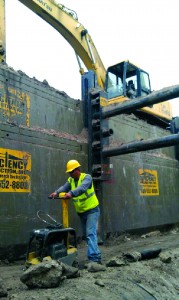November 2012, Vol. 67, No. 11
Features
Florida DOT Approves Project Switch To Slide Rail

Just one way: according to the Florida Department of Transportation (FDOT), there was only one approved method for shoring a trench within the right-of-way of an Interstate — driven tight sheeting.
So that was the shoring system in the bid when primary contractor Better Roads Inc. was chosen as low bidder to widen a critical stretch of Interstate I-75 near Tampa, including installing new storm sewers and other underground infrastructure.
But as most excavation contractors will tell you, tight sheeting a trench is time consuming, costly, requires specialized equipment and often means extended periods of down time for work crews.
“Installing sheet piling would have been tedious and could incur thousands of dollars in damages trying to drive the sheeting into the cap rock of the Pasco (Florida) area,” said Anthony Bosco, Project Manager for Haleakala Construction, Better Roads’ subcontractor responsible for installing 7,600 linear feet of new storm sewer RCP just 25-feet away from one of the busiest sections of freeway in the state.
Paul Strazzulla, shoring specialist for local equipment distributor Professional Shoring & Supply, had an opportunity to pitch to Better Roads and Haleakala the option of an Efficiency Production manufactured Slide Rail Shoring System as a potential alternative to sheeting. “Haleakala had used Slide Rail many times before, and so they knew it was a cost savings over sheeting,” said Strazzulla. “And Better Roads liked the idea that Slide Rail was a cheaper alternative to sheeting. It was really a matter of convincing the (Florida) DOT’s engineers that Slide Rail works like sheeting when it comes to meeting all the safety and environmental protection requirements.”

“The cost savings was about 15 to 20 percent over sheeting,” said Brent Harrison, Better Roads’ Project Manager. “I’d say we are gaining about 30 to 35 percent more pipe production using Slide Rail. Plus, you can train a good pipe crew to install Slide Rail, rather than needing to hire a specialized sheeting contractor.”
Efficiency’s Universal Slide Rail is a component shoring system comprised of steel panels (similar to trench shield sidewalls) and vertical steel posts. The highly versatile system can be used in a variety of configurations.
Getting approval
The first step to getting the approved shoring method changed from sheeting to Slide Rail was to submit a Valued Engineering Change Proposal (VECP) to FDOT. “Calculations, tab data, 3D CAD drawings, case studies; the state’s engineers wanted to see everything we had on Slide Rail,” added West.
In the end, after more than eight months of examination, consideration and multiple documentation from Efficiency, Better Roads and Keystone Engineering, FDOT’s contracted engineers on the project, did agree that Slide Rail was a cost savings over sheeting on this project, and could be used as an alternative positive shoring system. “Then it became a matter of paperwork,” said Bosco. “Because not only did the state need to say ‘yes, this is a cost savings’ but because this is a federally funded project, all the correct federal agencies needed to agree that it was a cost savings as well.”
The significance of this determination goes well beyond Better Road’s I-75 project. In the future, any contractors will be able to bid Slide Rail instead of sheeting for FDOT let projects.
Slide Rail is installed simultaneously as the trench or pit is excavated. “We can install it with our own machines and equipment,” said Harrison. “It is a lot easier to just switch out a bucket on your excavator with quick-connect, than having to bring in a hammer or even a crane.”
In comparing Slide Rail to traditional trench shields, again Slide Rail offers the biggest advantages. “Conventional shields are very stationary and once the spreader pipes or arches are in, you need to move the machine to dig out areas under the spreaders,” said George Carillo, Haleakala’s project foreman. “We can install pipe faster by using Slide Rail, due to the fact that Efficiency’s Slide Rail has parallel beams connecting regular trench box spreaders that move up and down in the linear posts so we could dig in and around the moving spreader pipe.”
Haleakala rented from Professional Shoring & Supply more than 300 feet of Slide Rail equipment, enough to configure a long Linear Multi-Bay system to safely shore the pipeline trench along I-75. The system included eight-foot tall, 16-foot wide steel panels that slide down integrated rails on 14-foot linear posts, creating more than 30 separate 16-foot wide “bays.”
“With the linear design, Haleakala is able to install pipe in the front ‘bays’ between the linear posts, while backfilling and removing the system in the back,” explained Brian Campbell, Professional Shoring’s senior Slide Rail installer who assisted the Haleakala crew with the initial installation of the system. “Then, the panels and posts that are pulled from the back can be installed into the front of the system ahead of where the pipe is going in. We call this ‘leap-frogging’ the system, and it allows the contractor to reutilize equipment which saves them money.”
While putting in the new pipeline, Haleakala encountered a crossing water-main and force-main, plus they had a 96 inch bored-in utility that needed to be tied into the new pipe. Again, more shoring challenges. Fortunately, Professional Shoring & Supply offers a Quicksheet Guideframe that integrates seamlessly into the linear Slide Rail System. Installed instead of the Slide Rail panels, the sheeting guide frame allows two-feet wide overlapping KD-6 sheeting to be positioned tightly around the crossing utility while maintaining “positive” pressure against the outside soil all the way to grade.
Green Technology Water Treatment System Protects Nearby Wetlands
FOR MORE INFORMATION:
Efficiency Production, (800) 552-8800, www.efficiencyproduction.com
Haleakala Construction Inc., (239) 598-1968, www.haleakalaconstruction.com.




Comments